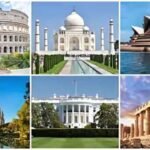Islands are indeed fascinating entities, each holding a distinct blend of natural beauty, cultural richness, and historical significance. The largest islands, such as Greenland, New Guinea, and Borneo, command attention not just for their size but for the diverse ecosystems and human societies they support.

Geographically, islands vary widely from volcanic archipelagos like Hawaii with their rugged landscapes and active volcanoes, to continental islands like Australia, which was once connected to larger landmasses. This diversity in formation contributes to unique ecosystems found on each island, often hosting endemic species that evolved in isolation.
Culturally, islands often have rich histories shaped by their isolation and interactions with neighboring regions. For example, the Caribbean islands bear the legacies of indigenous cultures, European colonization, and African influences through the transatlantic slave trade. Similarly, the islands of Southeast Asia reflect a blend of indigenous traditions with influences from Indian, Chinese, and Arab traders over centuries.
Economically, islands can be hubs of trade, tourism, and industry. Places like Singapore and Hong Kong thrive as economic powerhouses due to their strategic locations and favorable business environments. Tourism flourishes on islands known for their natural beauty and cultural attractions, such as Bali or the Maldives.
Despite their allure, islands also face unique challenges such as vulnerability to natural disasters like hurricanes and tsunamis, limited freshwater resources, and environmental threats from climate change and human activities. These challenges underscore the importance of sustainable development and conservation efforts to preserve both the natural environment and cultural heritage of islands worldwide.
Let’s delve into the top 10 largest islands in the world, each offering a distinct tapestry of natural beauty and cultural richness.
1. Greenland
Greenland, positioned in the North Atlantic Ocean, stands as the world’s largest island, spanning approximately 2,166,086 square kilometers. This vast territory is largely defined by its dramatic ice-covered landscapes, including expansive glaciers, intricate fjord systems, and colossal ice sheets that contribute significantly to global sea levels.
Geography and Climate: Greenland’s geography is characterized by its Arctic climate, where temperatures can plummet well below freezing for much of the year. The island’s interior is dominated by the Greenland Ice Sheet, covering about 80% of its landmass and containing enough ice to potentially raise global sea levels by several meters if melted completely. Surrounding this icy core are coastal regions dotted with fjords, formed by glacial erosion, and mountainous areas where vegetation can thrive during the short Arctic summers.
Wildlife and Environment: Despite its harsh conditions, Greenland supports a surprisingly diverse array of Arctic wildlife. Polar bears roam the sea ice hunting seals, while marine mammals such as whales and seals navigate the frigid waters along the coasts. The island is also a vital breeding ground for numerous seabird species, taking advantage of the rich marine ecosystems offshore.
Cultural Heritage: Greenland’s human history is deeply intertwined with its challenging environment. The island has been inhabited for over 4,500 years by indigenous peoples, primarily the Greenlandic Inuit. These resilient communities have adapted traditional hunting and fishing practices to survive in the Arctic, maintaining a strong cultural identity rooted in oral traditions, music, and art that reflect their deep connection to the land and sea.
Challenges and Sustainability: In recent decades, Greenland has faced significant environmental challenges due to climate change. Rising temperatures have accelerated the melting of its ice sheets and glaciers, leading to concerns about sea level rise and impacting local ecosystems and traditional ways of life. Additionally, the island’s economy, historically reliant on fishing and limited mineral resources, is navigating the complexities of modernization while striving to preserve its unique natural and cultural heritage.
2. New Guinea
New Guinea, situated in the region of Oceania and straddling the equator, is renowned as the second-largest island in the world, covering approximately 785,753 square kilometers. This vast landmass is celebrated not only for its size but also for its extraordinary biodiversity, diverse cultures, and stunning natural landscapes.
Geography and Natural Features: New Guinea’s geography is characterized by rugged mountain ranges, dense tropical rainforests, and extensive river systems. The island is divided politically into two main parts: the western half, known as Papua and West Papua, belonging to Indonesia, and the eastern half forming the independent nation of Papua New Guinea. Mount Wilhelm, towering at 4,509 meters (14,793 feet), is the highest peak on the island and outside of Australia, contributing to its varied topography that ranges from coastal plains to highland plateaus.
Biodiversity: New Guinea is recognized as one of the world’s most biodiverse regions, hosting an astonishing array of flora and fauna. Its tropical rainforests are home to numerous endemic species, including birds of paradise, tree kangaroos, and various orchid species. The island’s rich biodiversity has attracted scientists and nature enthusiasts alike, offering opportunities for research and conservation efforts to protect its unique ecosystems.
Cultural Diversity: The island of New Guinea is inhabited by a diverse mosaic of indigenous communities, each with its distinct languages, traditions, and social structures. Papua New Guinea alone is home to over 800 different languages, making it one of the most linguistically diverse regions on Earth. Traditional practices such as storytelling, music, dance, and intricate art forms continue to play a significant role in preserving cultural heritage amidst modern influences.
Challenges and Conservation: Despite its natural beauty and cultural richness, New Guinea faces significant challenges related to environmental conservation and sustainable development. Deforestation, mining activities, and climate change threaten the island’s fragile ecosystems and the livelihoods of its indigenous populations. Efforts are underway to promote sustainable practices, protect biodiversity hotspots, and empower local communities in conservation initiatives.
Tourism and Economy: Tourism in New Guinea is growing, with visitors drawn to its pristine natural landscapes, vibrant cultures, and opportunities for adventure tourism such as trekking and diving. Papua New Guinea’s economy is largely dependent on agriculture, mining, and natural resources, with efforts to diversify and promote sustainable tourism as a means of economic development.
3. Borneo
Borneo, situated in Southeast Asia and shared by Malaysia, Indonesia, and Brunei, stands as the third-largest island globally, encompassing approximately 748,168 square kilometers. This expansive landmass is renowned for its breathtaking natural beauty, rich biodiversity, and diverse cultural heritage.
Geography and Natural Features: Borneo’s geography is characterized by lush tropical rainforests, mountainous terrain, and extensive river systems. The island is home to Southeast Asia’s highest peak, Mount Kinabalu, standing at 4,095 meters (13,435 feet), which is a UNESCO World Heritage site and a prominent symbol of Borneo’s natural wonders. The rainforests of Borneo are among the oldest in the world, harboring an incredible diversity of plant and animal species, many of which are endemic to the region.
Biodiversity: Borneo is renowned for its exceptional biodiversity, hosting a wealth of endemic species that include the iconic orangutans, pygmy elephants, proboscis monkeys, and a vast array of bird and plant species. The island’s rainforests are crucial habitats for these species, making conservation efforts critical amidst ongoing threats such as deforestation, habitat loss, and illegal wildlife trade.
Cultural Diversity: Borneo’s cultural landscape is equally rich and diverse, shaped by indigenous Dayak tribes and influenced by Malay, Chinese, and other regional cultures. The Dayak communities, comprising various ethnic groups with distinct languages, traditions, and belief systems, have historically lived in harmony with the island’s natural environment, practicing animism and maintaining vibrant cultural practices that include traditional music, dance, and intricate handicrafts.
Tourism and Conservation Efforts: Borneo’s natural wonders and cultural heritage attract a growing number of tourists each year, drawn to opportunities for eco-tourism, wildlife viewing, and adventure activities such as trekking and river cruises. Conservation efforts on the island are focused on protecting biodiversity hotspots, promoting sustainable tourism practices, and empowering local communities to participate in conservation initiatives while supporting their livelihoods.
Economic Significance: Economically, Borneo’s resources play a crucial role in the economies of Malaysia, Indonesia, and Brunei, with industries such as agriculture, logging, and mining contributing to local economies. Efforts are increasingly being made to balance economic development with environmental sustainability and cultural preservation, ensuring that Borneo’s natural and cultural treasures can be enjoyed by future generations.
4. Madagascar
Madagascar, located in the Indian Ocean off the southeastern coast of Africa, is the fourth-largest island in the world, spanning approximately 587,041 square kilometers. This island nation is celebrated for its extraordinary biodiversity, diverse landscapes, and rich cultural heritage, making it a unique and compelling destination on the global stage.
Geography and Natural Diversity: Madagascar’s geography is characterized by a diverse array of ecosystems, ranging from lush rainforests and dry deciduous forests to unique spiny forests found in the southwestern region. The island’s varied topography includes mountains, plateaus, and coastal plains, contributing to its rich ecological tapestry. Notably, Madagascar is home to some of the world’s most distinctive flora and fauna, with a high percentage of species found nowhere else on Earth. Iconic species include lemurs, baobab trees, and the fossa, reflecting Madagascar’s isolation and evolutionary history.
Biodiversity Hotspot: Madagascar is renowned as a biodiversity hotspot, with over 90% of its wildlife being endemic. The island’s isolation over millions of years has resulted in the evolution of unique species adapted to its specific habitats. Efforts to conserve Madagascar’s biodiversity are crucial due to ongoing threats such as habitat loss, deforestation, and climate change impacts, which endanger many endemic species and their habitats.
Cultural Heritage: The Malagasy people, comprising diverse ethnic groups, trace their ancestry to Southeast Asian and East African settlers who arrived centuries ago. This cultural blend is reflected in Madagascar’s rich traditions, music, dance, and oral histories. Traditional rituals, such as famadihana (the turning of the bones), illustrate the deep connection between the Malagasy people and their ancestors, emphasizing spiritual beliefs and community bonds that endure to this day.
Challenges and Conservation Efforts: Madagascar faces significant challenges related to environmental conservation and sustainable development. Deforestation, driven by agriculture, logging, and charcoal production, threatens the island’s unique biodiversity and contributes to soil erosion and loss of natural habitats. Conservation efforts, supported by local communities, non-governmental organizations, and international partners, focus on protecting key biodiversity areas, promoting sustainable agriculture practices, and raising awareness about the importance of conservation among the Malagasy people.
Economic and Tourism Potential: Madagascar’s natural and cultural treasures also present opportunities for sustainable tourism development, attracting visitors interested in wildlife observation, ecotourism, and exploring unique landscapes and cultural traditions. Tourism has the potential to generate income for local communities while promoting conservation practices that safeguard Madagascar’s natural heritage for future generations.
5. Baffin Island
Baffin Island, situated in the Arctic Ocean and belonging to Canada, is the largest island in the country, spanning approximately 507,451 square kilometers. This remote and rugged landmass is characterized by its stark Arctic landscapes, rich wildlife, and vibrant indigenous culture, making it a significant part of Canada’s northern heritage.
Geography and Natural Features: Baffin Island’s geography is dominated by Arctic tundra, glaciers, and deep fjords carved by ancient ice sheets. The island’s coastline is intricately indented with fjords, providing sheltered habitats for a variety of marine life. Mount Thor, located in the Auyuittuq National Park, boasts one of the world’s highest vertical cliffs, adding to the island’s dramatic topography and attracting climbers and adventurers seeking to explore its challenging terrain.
Wildlife: Baffin Island supports a diverse array of Arctic wildlife, including iconic species such as polar bears, Arctic foxes, caribou, and marine mammals like beluga whales and seals. The island’s rich marine ecosystems are vital for these species, which have adapted to survive in the harsh Arctic environment, relying on sea ice and coastal habitats for hunting, breeding, and migration.
Inuit Communities and Cultural Heritage: Inuit communities have inhabited Baffin Island for millennia, adapting traditional hunting and fishing practices to sustain their livelihoods in the Arctic environment. These communities, deeply connected to their ancestral lands, maintain strong cultural traditions that include storytelling, drum dancing, throat singing, and intricate artistic expressions such as soapstone carving and printmaking. Traditional knowledge passed down through generations continues to shape daily life and foster resilience in the face of environmental and social challenges.
Challenges and Conservation Efforts: Baffin Island faces challenges related to climate change, resource development, and preserving cultural heritage. Rapid warming in the Arctic threatens traditional hunting practices, while industrial activities such as mining and oil exploration raise concerns about environmental impacts and their effects on wildlife and local communities. Conservation efforts focus on balancing economic development with environmental stewardship and cultural preservation, promoting sustainable practices and empowering Inuit communities to participate in decision-making processes that affect their lands and livelihoods.
Tourism and Economic Opportunities: Tourism in Baffin Island is growing, driven by interest in Arctic wildlife, indigenous cultures, and adventure tourism activities such as hiking, kayaking, and wildlife watching. Sustainable tourism practices aim to minimize environmental impact while providing economic opportunities for local communities through guided tours, cultural experiences, and artisanal crafts.
6. Sumatra
Sumatra, located in Indonesia between the Indian and Pacific Oceans, is renowned as the sixth-largest island in the world, covering approximately 443,066 square kilometers. This diverse and culturally rich island is celebrated for its lush tropical rainforests, unique wildlife, volcanic landscapes, and vibrant cultural heritage.
Geography and Natural Features: Sumatra’s geography is characterized by its tropical rainforests, which are considered crucial for biodiversity and are often referred to as the “lungs of Southeast Asia.” These forests are home to a remarkable array of flora and fauna, including endangered species such as the Sumatran tiger, Sumatran orangutans, elephants, and the rare Rafflesia arnoldii, the largest flower in the world. Volcanic peaks, such as Mount Kerinci, Indonesia’s highest volcano at 3,805 meters (12,484 feet), punctuate the island’s landscapes, offering opportunities for adventurous treks through dense jungle and mist-shrouded summits.
Biodiversity and Conservation: Sumatra is recognized as one of the world’s biodiversity hotspots due to its high levels of endemism and species richness. However, the island faces significant conservation challenges, including deforestation, illegal wildlife trade, and habitat loss due to agricultural expansion, particularly for palm oil plantations. Conservation efforts are focused on protecting remaining forests, establishing wildlife reserves, and promoting sustainable practices that balance economic development with environmental conservation.
Cultural Heritage: Sumatra’s cultural heritage reflects a blend of influences from Hindu-Buddhist kingdoms that once flourished in the region, followed by Islamic sultanates that shaped the island’s traditions, arts, and architecture. Traditional ceremonies, such as weddings, festivals, and ritual performances, play a significant role in Sumatran communities, showcasing intricate dances, music, and elaborate costumes that highlight the island’s cultural diversity and historical legacy.
Economic Activities and Tourism: Economically, Sumatra is important for Indonesia, contributing to the nation’s agriculture, mining, and tourism sectors. Tourism is growing on the island, attracting visitors interested in exploring its natural wonders, cultural heritage, and outdoor activities such as trekking, wildlife watching, and visiting historical sites. Sustainable tourism practices aim to minimize environmental impact while providing economic benefits to local communities through guided tours, eco-lodges, and cultural experiences.
7. Honshu
Honshu, the largest and most populous island of Japan, is situated in the North Pacific Ocean, covering approximately 227,898 square kilometers. This diverse island is celebrated for its stunning natural landscapes, vibrant cities, rich cultural heritage, and significant contributions to Japan’s historical and contemporary identity.
Geography and Natural Features: Honshu’s geography is characterized by a varied terrain that includes snow-capped mountains, lush forests, fertile plains, and picturesque coastlines. The iconic Mount Fuji, Japan’s highest peak at 3,776 meters (12,389 feet), stands as a symbol of natural beauty and cultural significance, attracting climbers and tourists from around the world. The island is also dotted with numerous hot springs (onsen), reflecting its volcanic origins and providing relaxation and therapeutic benefits to visitors.
Cultural Heritage: Honshu boasts a rich cultural heritage shaped by centuries of history and diverse influences. Shinto shrines and Buddhist temples, such as the famous Meiji Shrine in Tokyo and the historic temples of Kyoto, offer insights into traditional Japanese spirituality and architectural splendor. Honshu is also renowned for its traditional arts and crafts, including tea ceremony (chanoyu), ikebana (flower arranging), kabuki theater, and the elegant art of Japanese gardens, each reflecting meticulous attention to detail and profound cultural significance.
Modern Cities and Innovation: Honshu is home to Japan’s vibrant and bustling cities, including the capital Tokyo, which ranks among the world’s most populous and technologically advanced urban centers. Tokyo’s skyline blends modern skyscrapers with historic temples and bustling markets, offering a glimpse into Japan’s dynamic fusion of tradition and innovation. Other major cities like Osaka, Kyoto, and Yokohama contribute to Honshu’s cultural tapestry through their distinctive local cuisines, traditional festivals, and thriving arts scenes.
Samurai Heritage and Historical Sites: Honshu’s history is marked by the legacy of samurai warriors, who played a pivotal role in shaping Japan’s feudal period and cultural identity. Historical sites such as Himeji Castle, known for its elegant white facade and strategic fortifications, exemplify the architectural prowess and military strategies of Japan’s samurai clans. Honshu’s feudal era castles, gardens, and preserved traditional districts provide a window into Japan’s feudal past and the enduring legacy of bushido (samurai code of honor).
Tourism and Cultural Exchange: Tourism in Honshu continues to thrive, attracting millions of visitors annually who seek to explore its natural wonders, historical landmarks, and cultural treasures. The island’s efficient transportation network, including the famous Shinkansen (bullet trains), facilitates travel between major cities and remote regions, enhancing accessibility to Honshu’s diverse attractions and promoting cultural exchange on a global scale.
8. Victoria Island
Victoria Island, located in Canada’s Arctic Archipelago, is the eighth-largest island in the world, spanning approximately 217,291 square kilometers. This remote and rugged island is characterized by its pristine Arctic landscapes, rich biodiversity, and vibrant indigenous culture, making it a significant part of Canada’s northern heritage.
Geography and Natural Features: Victoria Island’s geography is dominated by Arctic tundra, vast plains, rugged coastlines, and scattered lakes. The island experiences extreme Arctic conditions, with long, harsh winters and short, cool summers. Glaciers and ice caps dot the landscape, contributing to its stark and untouched beauty. The island’s northernmost point, Cape Columbia, is also the northernmost point of land in Canada.
Wildlife and Biodiversity: Victoria Island supports a diverse array of Arctic wildlife adapted to its challenging environment. Iconic species include caribou, muskoxen, Arctic foxes, polar bears, and numerous bird species that migrate to the island’s coastal areas during the summer months. The surrounding waters are also rich in marine life, supporting seals, whales, and various fish species that are essential to the subsistence of local communities.
Inuit Communities and Cultural Heritage: Inuit communities have inhabited Victoria Island for millennia, adapting traditional hunting, fishing, and crafting practices to survive and thrive in the Arctic environment. These communities, such as those belonging to the Inuvialuit and Inuit Nunangat regions, maintain strong cultural ties to the land and sea, embodying a way of life deeply rooted in respect for nature, oral traditions, and artistic expressions. Inuit art, including carvings, sculptures, and textile arts, reflects themes of Arctic wildlife, spiritual beliefs, and community life.
Challenges and Conservation Efforts: Victoria Island faces environmental challenges such as climate change, which is causing rapid warming in the Arctic and affecting wildlife habitats and traditional hunting grounds. Conservation efforts focus on preserving biodiversity, promoting sustainable resource management, and empowering indigenous communities to participate in decision-making processes that affect their lands and livelihoods. Efforts are also underway to mitigate the impacts of industrial activities and climate change on Arctic ecosystems and indigenous cultures.
Cultural Resilience and Community Development: Inuit communities on Victoria Island continue to demonstrate resilience and adaptability in the face of environmental and social changes. Efforts to support community-led initiatives, cultural revitalization, and sustainable development are essential to preserving Victoria Island’s unique cultural heritage and ensuring the well-being of its inhabitants for future generations.
9. Great Britain
Great Britain, situated off the northwest coast of mainland Europe in the North Atlantic Ocean, is renowned for its rich history, diverse landscapes, and cultural heritage, spanning approximately 209,331 square kilometers. This island nation comprises the countries of England, Scotland, and Wales, each contributing distinct geographical features and cultural identities to its storied tapestry.
Geography and Natural Diversity: Great Britain’s geography is characterized by varied landscapes that range from rugged highlands and mountains to rolling hills, fertile plains, and picturesque coastlines. Scotland, located in the north, is dominated by the Highlands and the Grampian Mountains, including iconic peaks such as Ben Nevis, the highest mountain in the British Isles. England, in the south, is renowned for its rolling green countryside, historic cities, and cultural landmarks like Stonehenge and the Lake District National Park. Wales, to the west, boasts dramatic coastal cliffs, mountainous regions such as Snowdonia National Park, and a rich Celtic heritage.
Cultural History and Heritage: Great Britain’s cultural history is a tapestry woven with influences from Celtic tribes, Roman conquerors, Anglo-Saxon kingdoms, Norman invaders, and subsequent waves of immigration and cultural exchange. This diverse history is reflected in its architecture, traditions, language, and arts. Historic landmarks such as Hadrian’s Wall, Edinburgh Castle, Buckingham Palace, and the Tower of London stand as testaments to the island’s centuries-old heritage and royal history.
Literary and Artistic Inspiration: Great Britain’s landscapes, with their evocative beauty and historical significance, have inspired generations of poets, writers, artists, and filmmakers. From William Wordsworth’s romantic odes to the Lake District’s natural beauty to J.M.W. Turner’s dramatic seascapes and the literary works of Shakespeare, Dickens, and Rowling, Great Britain’s cultural contributions to the world are deeply rooted in its landscapes and historical settings.
Modern Society and Global Influence: Today, Great Britain remains a global center of influence in diverse fields such as finance, culture, education, and technology. Cities like London, Edinburgh, Cardiff, and Belfast serve as vibrant hubs of creativity, innovation, and multiculturalism, attracting tourists, students, and professionals from around the world. The United Kingdom’s political institutions, including the British Parliament and the monarchy, continue to shape its national identity and international relations.
10. Ellesmere Island
Ellesmere Island, located in Canada’s Arctic Archipelago, is renowned for its stark beauty, extreme environment, and cultural heritage, spanning approximately 196,236 square kilometers. This remote and pristine island offers a unique glimpse into the Arctic’s natural wonders and the resilience of its indigenous communities.
Geography and Natural Features: Ellesmere Island’s geography is characterized by its polar desert environment, featuring icy fjords, rugged mountains, glaciers, and vast expanses of barren tundra. It is the most northerly island in the Arctic Archipelago, experiencing long, frigid winters and brief, cool summers. The island’s northernmost point, Cape Columbia, is also the northernmost point of land in Canada, emphasizing its extreme Arctic conditions.
Wildlife and Biodiversity: Despite its harsh environment, Ellesmere Island supports a surprising diversity of Arctic wildlife adapted to survive in the challenging climate. Iconic species include muskoxen, Arctic wolves, Arctic foxes, polar bears, and numerous bird species that migrate to the island during the brief Arctic summer to breed and feed. The surrounding Arctic waters are also rich in marine life, supporting seals, whales, and fish that play vital roles in the island’s ecosystem.
Inuit Culture and Heritage: Inuit communities have inhabited Ellesmere Island for millennia, relying on traditional hunting, fishing, and crafting skills to sustain their way of life in harmony with the Arctic environment. These communities, such as those belonging to the Inuit Nunangat region, maintain strong cultural traditions rooted in respect for nature, oral histories, and artistic expressions. Inuit art, including sculpture, printmaking, and traditional clothing, reflects themes of Arctic wildlife, spiritual beliefs, and the cultural resilience of indigenous peoples in the face of environmental and social challenges.
Challenges and Conservation Efforts: Ellesmere Island faces environmental challenges related to climate change, which is causing rapid warming in the Arctic and affecting wildlife habitats, sea ice dynamics, and traditional hunting grounds. Conservation efforts are focused on protecting biodiversity, promoting sustainable resource management practices, and empowering Inuit communities to participate in decision-making processes that affect their lands and livelihoods. Efforts to mitigate the impacts of industrial activities and climate change on Arctic ecosystems are crucial to preserving Ellesmere Island’s unique natural and cultural heritage for future generations.
Tourism and Educational Opportunities: Tourism in Ellesmere Island is limited due to its remote location and extreme climate; however, it attracts adventurous travelers and researchers interested in Arctic ecosystems, wildlife observation, and indigenous cultures. Scientific research conducted on the island contributes valuable insights into climate change impacts, Arctic biodiversity, and environmental conservation strategies.
Conclusion:
The largest islands in the world are not only vast expanses of land but also repositories of ecological diversity, cultural heritage, and natural wonders. From the icy realms of Greenland to the tropical rainforests of Borneo and the cultural treasures of Honshu, each island offers a unique window into our planet’s geological and cultural tapestry. Whether you seek adventure, tranquility, or cultural immersion, exploring these remarkable islands promises unforgettable experiences and deeper insights into our interconnected world.
Additional Tips:
- Enrich the narrative with captivating images of each island’s landscapes, wildlife, and cultural highlights.
- Provide links to further reading, travel guides, or resources for those interested in exploring these destinations.
- Encourage readers to share their favorite island experiences or dream destinations, fostering engagement and community discussion.
FAQs
1. What is the largest island in the world?
- Answer: Greenland is the largest island in the world by area, spanning approximately 2,166,086 square kilometers.
2. Where is Greenland located?
- Answer: Greenland is located in the North Atlantic Ocean, within the Arctic Circle.
3. What is unique about New Guinea?
- Answer: New Guinea is renowned for its biodiversity, with tropical rainforests hosting diverse flora and fauna, including endemic species like birds of paradise.
4. What countries share the island of Borneo?
- Answer: Borneo is shared by Malaysia, Indonesia, and Brunei.
5. What is the significance of Madagascar’s biodiversity?
- Answer: Madagascar is a biodiversity hotspot, home to lemurs, baobab trees, and numerous endemic species found nowhere else on Earth.
6. What Arctic wildlife can be found on Baffin Island?
- Answer: Baffin Island is home to Arctic wildlife such as polar bears, Arctic foxes, and beluga whales.
7. What is notable about Sumatra’s geography?
- Answer: Sumatra features volcanic peaks, dense rainforests, and diverse ecosystems supporting species like the Sumatran tiger.
8. What are some cultural highlights of Honshu?
- Answer: Honshu, Japan’s main island, is known for Mount Fuji, Tokyo’s modern metropolis, and Kyoto’s historic temples.
9. What Arctic wildlife resides on Victoria Island?
- Answer: Victoria Island supports Arctic wildlife such as caribou, muskoxen, and polar bears.
10. What historical landmarks are found in Great Britain?
- Answer: Great Britain boasts historical landmarks like Stonehenge, Edinburgh Castle, and the Tower of London.
11. How is Ellesmere Island’s environment characterized?
- Answer: Ellesmere Island is characterized by polar desert landscapes, glaciers, and Arctic wildlife adapted to extreme conditions.
12. What is the cultural heritage of Greenland’s Inuit population?
- Answer: Greenland’s Inuit population has a rich cultural heritage tied to traditional hunting, storytelling, and art.
13. What is the climate like on New Guinea?
- Answer: New Guinea has a tropical climate with diverse ecosystems ranging from rainforests to mountains.
14. What are the major cities on Borneo?
- Answer: Major cities on Borneo include Kuching and Kota Kinabalu in Malaysia, Pontianak in Indonesia, and Bandar Seri Begawan in Brunei.
15. What are Madagascar’s main economic activities?
- Answer: Madagascar’s economy relies on agriculture, mining, and tourism, showcasing its natural wonders and cultural heritage.
16. How do people adapt to the Arctic climate on Baffin Island?
- Answer: Inuit communities on Baffin Island have adapted to the Arctic climate through traditional hunting and gathering practices.
17. What are Sumatra’s environmental challenges?
- Answer: Sumatra faces environmental challenges such as deforestation due to palm oil plantations and illegal logging.
18. What traditional arts are practiced on Honshu?
- Answer: Honshu is known for traditional arts such as tea ceremony, ikebana (flower arranging), and kabuki theater.
19. How do Inuit communities on Victoria Island sustain their livelihoods?
- Answer: Inuit communities on Victoria Island sustain their livelihoods through hunting, fishing, and crafting traditional Inuit art.
20. What are some famous authors and literary works associated with Great Britain?
- Answer: Great Britain has produced famous authors like William Shakespeare, Charles Dickens, and Jane Austen, whose works have left an indelible mark on literature worldwide.











